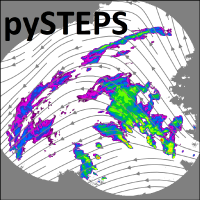pysteps.tracking.tdating.dating
pysteps.tracking.tdating.dating¶
- pysteps.tracking.tdating.dating(input_video, timelist, mintrack=3, cell_list=None, label_list=None, start=0, minref=35, maxref=48, mindiff=6, minsize=50, minmax=41, mindis=10, dyn_thresh=False)¶
This function performs the thunderstorm detection and tracking DATing. It requires a 3-D input array that contains the temporal succession of the 2-D data array of each timestep. On each timestep the detection is performed, the identified objects are advected with a flow prediction and the advected objects are matched to the newly identified objects of the next timestep. The last portion re-arranges the data into tracks sorted by ID-number.
- Parameters
- input_video: array-like
Array of shape (t,m,n) containing input image, with t being the temporal dimension and m,n the spatial dimensions. Thresholds are tuned to maximum reflectivity in dBZ with a spatial resolution of 1 km and a temporal resolution of 5 min. Nan values are ignored.
- timelist: list
List of length t containing string of time and date of each (m,n) field.
- mintrack: int, optional
minimum duration of cell-track to be counted. The default is 3 time steps.
- cell_list: list or None, optional
If you wish to expand an existing list of cells, insert previous cell-list here. The default is None. If not None, requires that label_list has the same length.
- label_list: list or None, optional
If you wish to expand an existing list of cells, insert previous label-list here. The default is None. If not None, requires that cell_list has the same length.
- start: int, optional
If you wish to expand an existing list of cells, the input video must contain 2 timesteps prior to the merging. The start can then be set to 2, allowing the motion vectors to be formed from the first three grids and continuing the cell tracking from there. The default is 0, which initiates a new tracking sequence.
- minref: float, optional
Lower threshold for object detection. Lower values will be set to NaN. The default is 35 dBZ.
- maxref: float, optional
Upper threshold for object detection. Higher values will be set to this value. The default is 48 dBZ.
- mindiff: float, optional
Minimal difference between two identified maxima within same area to split area into two objects. The default is 6 dBZ.
- minsize: float, optional
Minimal area for possible detected object. The default is 50 pixels.
- minmax: float, optional
Minimum value of maximum in identified objects. Objects with a maximum lower than this will be discarded. The default is 41 dBZ.
- mindis: float, optional
Minimum distance between two maxima of identified objects. Objects with a smaller distance will be merged. The default is 10 km.
- Returns
- track_list: list of dataframes
Each dataframe contains the track and properties belonging to one cell ID. Columns of dataframes: ID - cell ID, time - time stamp, x - array of all x-coordinates of cell, y - array of all y-coordinates of cell, cen_x - x-coordinate of cell centroid, cen_y - y-coordinate of cell centroid, max_ref - maximum (reflectivity) value of cell, cont - cell contours
- cell_list: list of dataframes
Each dataframe contains the detected cells and properties belonging to one timestep. The IDs are already matched to provide a track. Columns of dataframes: ID - cell ID, time - time stamp, x - array of all x-coordinates of cell, y - array of all y-coordinates of cell, cen_x - x-coordinate of cell centroid, cen_y - y-coordinate of cell centroid, max_ref - maximum (reflectivity) value of cell, cont - cell contours
- label_list: list of arrays
Each (n,m) array contains the gridded IDs of the cells identified in the corresponding timestep. The IDs are already matched to provide a track.
